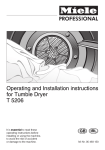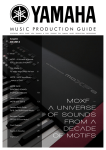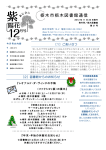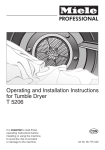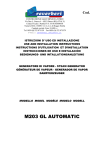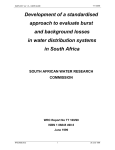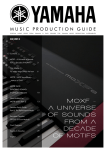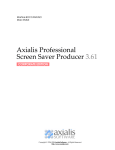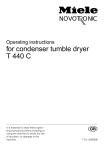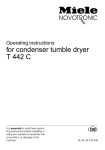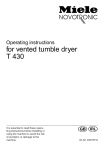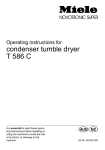Download Miele T 5205 C Operating instructions
Transcript
Operating and Installation instructions for Condensor Tumble Dryer T 5205 C It is essential to read these operating instructions before installing or using the machine, to avoid the risk of accident or damage to the machine. Q M.-Nr.: 04 076 300 Contents Contents Warning and safety instructions. . . . . . . . . . . . . . . . . . . . . . . . . . . . . . . . . . . . . . 4 Help to protect the environment Disposal of the packing material . . . . . . . . . . . . . . . . . . . . . . . . . . . . . . . . . . . . . . . 7 Disposal of your old machine. . . . . . . . . . . . . . . . . . . . . . . . . . . . . . . . . . . . . . . . . . 7 Energy saving tips . . . . . . . . . . . . . . . . . . . . . . . . . . . . . . . . . . . . . . . . . . . . . . . . . . 7 Guide to the machine Control panel . . . . . . . . . . . . . . . . . . . . . . . . . . . . . . . . . . . . . . . . . . . . . . . . . . . . . . 8 Explanation of control panel. . . . . . . . . . . . . . . . . . . . . . . . . . . . . . . . . . . . . . . . . . . 9 Use of the appliance . . . . . . . . . . . . . . . . . . . . . . . . . . . . . . . . . . . . . . . . . . . . . . . . 9 Preparation of laundry . . . . . . . . . . . . . . . . . . . . . . . . . . . . . . . . . . . . . . . . . . . . . 10 Programme chart . . . . . . . . . . . . . . . . . . . . . . . . . . . . . . . . . . . . . . . . . . . . . . . . 11 How to dry correctly. . . . . . . . . . . . . . . . . . . . . . . . . . . . . . . . . . . . . . . . . . . . . . . 1 Prepare the laundry . . . . . . . . . . . . . . . . . . . . . . . . . . . . . . . . . . . . . . . . . . . . . . 2 Load the drum . . . . . . . . . . . . . . . . . . . . . . . . . . . . . . . . . . . . . . . . . . . . . . . . . . 3 Select a programme . . . . . . . . . . . . . . . . . . . . . . . . . . . . . . . . . . . . . . . . . . . . . 4 Start a programme. . . . . . . . . . . . . . . . . . . . . . . . . . . . . . . . . . . . . . . . . . . . . . . 5 At the end of a programme . . . . . . . . . . . . . . . . . . . . . . . . . . . . . . . . . . . . . . . . 13 13 13 14 14 14 Changing a programme To cancel a programme. . . . . . . . . . . . . . . . . . . . . . . . . . . . . . . . . . . . . . . . . . . . . 15 Adding or removing items . . . . . . . . . . . . . . . . . . . . . . . . . . . . . . . . . . . . . . . . . . . 15 To select a different programme during drying . . . . . . . . . . . . . . . . . . . . . . . . . . . 15 2 Contents Cleaning and care Cleaning the fluff filters. . . . . . . . . . . . . . . . . . . . . . . . . . . . . . . . . . . . . . . . . . . . . . 16 Casing and drum . . . . . . . . . . . . . . . . . . . . . . . . . . . . . . . . . . . . . . . . . . . . . . . . . . 17 Heat exchanger . . . . . . . . . . . . . . . . . . . . . . . . . . . . . . . . . . . . . . . . . . . . . . . . . . . 18 Problem solving guide What to do if . . . ? . . . . . . . . . . . . . . . . . . . . . . . . . . . . . . . . . . . . . . . . . . . . . . . . . 20 To change the lamp . . . . . . . . . . . . . . . . . . . . . . . . . . . . . . . . . . . . . . . . . . . . . . . . 24 Service . . . . . . . . . . . . . . . . . . . . . . . . . . . . . . . . . . . . . . . . . . . . . . . . . . . . . . . . . . 25 Installation View from the front . . . . . . . . . . . . . . . . . . . . . . . . . . . . . . . . . . . . . . . . . . . . . . . . View from the rear . . . . . . . . . . . . . . . . . . . . . . . . . . . . . . . . . . . . . . . . . . . . . . . . . Aligning the machine . . . . . . . . . . . . . . . . . . . . . . . . . . . . . . . . . . . . . . . . . . . . . . Coin mechanism / Time counter . . . . . . . . . . . . . . . . . . . . . . . . . . . . . . . . . . . . . . 26 27 28 28 Electrical connection . . . . . . . . . . . . . . . . . . . . . . . . . . . . . . . . . . . . . . . . . . . . . 29 Electrical connection U.K. . . . . . . . . . . . . . . . . . . . . . . . . . . . . . . . . . . . . . . . . . . . 29 External drainage of the condensed water . . . . . . . . . . . . . . . . . . . . . . . . . . . . 31 Technical data . . . . . . . . . . . . . . . . . . . . . . . . . . . . . . . . . . . . . . . . . . . . . . . . . . . 32 3 Warning and safety instructions Warning and safety instructions Please read the operating instructions before using the tumble dryer for the first time. They contain important information about the safety, use and maintenance of the machine. This way you will avoid the risk of accidents and damage to the machine. Keep these operating instructions in a safe place and ensure that new users are familiar with the content. Pass them on to any future owner of the machine. Correct use The tumble dryer is only intended for drying fabrics which have been washed in a water solution, marked on the manufacturer’s wash care label as being suitable for tumble drying. Any other applications may be dangerous. The manufacturer is not liable for damage resulting from improper use or operation. Do not let small children play with the machine or its controls. Supervise its use by the elderly or infirm. Technical safety Before setting up the machine check it for any externally visible damage. Do not install or use a damaged machine. Before connecting the machine, ensure that the connection data on the data plate (fusing, voltage and frequency) matches the mains electricity supply. If in any doubt, consult a qualified electrician. 4 The electrical safety of this machine can only be guaranteed when continuity is complete between the appliance and an effective earthing system which complies with local and national regulations. It is most important that this basic safety requirement is regularly tested by a qualified electrican. The manufacturer cannot be held responsible for the consequences of an inadequate earthing system (e.g. electric shock). Do not connect the machine to the mains electricity supply by an extension lead. Extension leads do not guarantee the required safety of the machine (e.g. danger or overheating). The machine is built in accordance with current safety requirements. Unauthorised repairs could result in unforeseen dangers for the user, for which the manufacturer cannot accept responsibility. Repairs should only be undertaken by a Miele approved engineer. Faulty components must only be exchanged for Miele original spare parts. Only when these parts are fitted can the safety standards of the machine be guaranteed. Warning and safety instructions In the event of a fault or for cleaning purposes, the machine is only completely isolated from the electricity supply either when: – the plug is withdrawn, or – it is switched off at the mains, or – the mains fuse is withdrawn. The dryer must not be used without the fluff filters in place or if the fluff filters are damaged in any way. The dryer must not be used without the heat exchanger in place. Do not install the machine in a room where the temperature may drop below freezing. At very cold temperatures the machine may be difficult to start. Laundry will not dry, and the sequence indicator light ~ r Anti-crease / End will flash to indicate a problem. Make sure the drain hose is securely attached if you hang it in a sink or basin (external drainage of condensed water) to avoid the hose slipping and the water causing damage. Condensed water is not drinking water. It can cause health problems in both people and animals. Always close the door after use. This way you will avoid the danger of: – anyone sitting or leaning on the door, which can cause the machine to tip up. – children climbing onto or into the dryer or hiding things in it. Always keep the area around the machine free of dust and fluff. There is a risk of damage if the condensed water is allowed to freeze in the pump, hoses and / or condensed water container. 5 Warning and safety instructions There is a danger of fire with fabrics which: – contain rubber, foam rubber or rubber like materials – have been treated with inflammable cleaning agents – have been splashed with hair lacquer, hair spray, nail varnish remover or similar substances – which contain padding or fillings (e.g. pillows, jackets). If these were damaged the filling could get out with the risk of igniting in the dryer. Avoid contact of stainless steel surfaces (front, lid, casing) with liquid cleaning and disinfecting agents which contain chlorine or sodium hypochlorite. These agents can have a corrosive effect on stainless steel. Aggressive vapours containing chlorine bleach can also be corrosive. Do not store open containers or these agents near the machine. 6 Using accessories Accessory parts may only be fitted when expressly approved by Miele. If other parts are used, guarantee, performance and product liability claims may be invalidated. Disposal of your old machine Before discarding an old machine unplug it and render the plug useless. Cut off the cable directly behind the appliance to prevent misuse. Help to protect the environment Help to protect the environment Disposal of the packing material The transport and protective packing has been selected from materials which are environmentally friendly for disposal and can normally be recycled. Rather than just throwing these materials away, please ensure they are offered for recycling. Disposal of your old machine Old machines contain materials which can be reclaimed or recycled. Please contact your dealer, your local waste collection centre or scrap merchant about potential recycling schemes. Ensure that the machine presents no danger to children while being stored for disposal. Energy saving tips Make sure that your laundry is thoroughly spun before drying. You will save up to 30% energy and time if laundry is spun at 1200 rpm instead of at 600 rpm. Load according to the optimum amount of washing recommended for the programme being used. Underloading is uneconomical. Overloading gives a poorer quality of drying and may cause unnecessary creasing. To save energy and time: – Make sure the room in which the dryer is located is well ventilated. – Make sure the fluff filter is clean before using the dryer. 7 Guide to the machine Guide to the machine Control panel Opens the drum door Programme sequence Drying ! ä Cool air ~ r Anti-crease/End n Light Programme selector Illuminates the drum The programme selector can be turned clockwise or anti-clockwise. Pushbutton switches a Door L Low temperature Lower drying temperatures (for delicate fabrics with the care label r, e.g. acrylics) h Start Starts a programme A 1 2 3 4 5 6 Cottons B 7 8 9 Minimum iron Extra dry Normal + Normal Hand iron r Hand iron rr Machine iron Additional display ( above the pushbutton switches) Displays the drying stage reached. Displays “0” at anti-crease stage. Nothing is displayed with timed drying. Normal + Normal Hand iron q “Check drain” indicator light C Timed drying 0 Cool air 15 mins ! Hot air 20 mins 8 Guide to the machine Explanation of control panel Use of the appliance A small panel is supplied with the machine to explain the symbols on the control panel. Position this on the left hand side next to the control panel. This automatic tumble dryer is particularly suitable for use in communal laundry rooms, laundrettes etc. where considerable amounts of soiled laundry are dealt with. Set the small panel into the lower guide, press downwards and at the same time slot into the upper guide. 9 Preparation of laundry Preparation of laundry Wash care labels Before drying check the drying symbol on the wash care label. Significance of symbols: q = Dry at normal temperature r = Dry at low temperature s = Do not tumble dry If no symbol is featured dry at your own risk applying the following principles: Cottons and minimum iron items should be dried at a normal temperature using the appropriate programme setting. Delicate fabrics with the following wash care label r, e.g. acrylics should be dried at a low temperature. The following fabrics should not be dried in a tumble dryer: Woollens and wool blends these fabrics tend to become matted and shrink. Items filled with down the fine fabric interior tends to shrink, depending on the quality involved. Pure linen should only be machine dried if specified as suitable by the manufacturer on the wash care label, as the surface of the fabric may otherwise tend to roughen. 10 General notes Woven and loopkit materials (e.g. TShirts, knitted garments) tend to shrink to varying extents depending on their quality. This tendency is exaggerated by over-drying. When purchasing woven materials, it is advisable to take their shrinkage properties into account. Starched laundry can be dried in the tumble dryer. To achieve the usual finish, double the amount of starch should be used. Minimum iron fabrics should be spun briefly at the end of their wash programme, or spun for 10 to 30 seconds if hand washed before they are dried. Some fabrics tend to crease if overdried. These items should be given only a short period in the dryer, and taken out slightly damp. Do not use the B Minimum iron - 7 Normal+ programme for these fabrics. Minimum iron shirts in 100% cotton may crease during tumble drying depending on the quality of the weave. These should be dried using the Hand iron 9 setting. In extreme cases drip dry on a coat hanger. Minimum iron fabrics tend to crease more the greater the load. This is particulary the case with delicate fabrics. The load should be reduced to 2 kg or if necessary to 1.5 kg. New dark coloured garments should be dried separately from light coloured garments to avoid the danger of colours running. Programme chart Programme chart Programme A COTTONS 1 Extra dry 2 Normal+ 3 Normal (EN 61121) 4 Hand iron r 5 Hand iron rr (EN 61121) 6 Machine iron 1) Laundry / Fabric type max. load 1) Multi-layered fabrics which would not be thoroughly dried using the 2 Normal+ programme. Mixed loads of cotton fabrics, e.g. Turkish towelling and jerseywear, i.e. single and multi - layer fabrics. Loads of similar cotton fabrics (jerseywear, flannelette sheets, Turkish towelling). 6 kg Notes To prevent shrinkage do not select the 1 Extra dry programme for jerseywear. 6 kg 6 kg Cotton or linen fabrics, e.g. table linen, bedding, starched laundry, etc. 6 kg Cotton or linen fabrics, also starched laundry, for machine ironing. 6 kg 6 kg Should certain items still be slightly damp, select the 1 Extra dry or 2 Normal + programmes If fabrics are too damp for hand ironing, select the 4 Hand iron r programme. Laundry should be rolled up to prevent it from drying out until it can be ironed. Weight of dry laundry 11 Programme chart Programme Laundry / Fabric type B MINIMUM IRON Minimum iron items 7 Normal + 8 Normal (EN 61121) 9 Hand iron C Timed drying 0 Cold air ! Hot air 1) made of synthetics or blended fabrics, e.g. pullovers,dresses, trousers etc., which are not dried adequately in the 8 Normal programme. Minimum iron shirts, table cloths, etc., made of blended fabrics, e.g. cotton/synthetics. Minimum iron shirts, table cloths, etc., made of blended fabrics, e.g. cotton/synthetics which are still to be handironed. Items which are only to be aired. Individual items, e.g. towels. Weight of dry laundry 12 max. load 1) Notes 3 kg With blended fabrics consisting of wool and synthetics, consult the manufacturer’s instructions, as the wool component may cause the fabric to become matted. 3 kg 3 kg 6 kg - 6 kg - How to dry correctly How to dry correctly 1 Prepare the laundry As far as possible, sort laundry for: – the type of fibre or weave Do not overload the drum. Overloading can cause unnecessary wear and tear to the laundry and give a disappointing drying result. – the degree of dryness required, – similar size of items – the moisture content after spinning. This will help towards achieving an even drying result. See the programme chart for maximum loads. Before closing the door check that the fluff filter is correctly positioned. Fasten duvet covers etc. to prevent small items from being rolled up inside them. Do up zips and tie fabric belts and apron strings. Make sure there is no detergent dispenser ball etc. in with the laundry, as this could melt and damage the machine and the laundry. 2 Load the drum Press the door button a and open the door. Load the laundry loosely into the drum. Important: Please check that items of laundry cannot be trapped by the door, as this will cause damage to the fabric. Shut the door with a firm swing. 13 How to dry correctly 3 Select a programme Turn the programme selector to the programme required. Select low temperature L if required. If the machine is fitted with a coin mechanism / time counter: 5 At the end of a programme Turn the programme selector to the r End position. Press the door a button to open the door. Press the Light n button. Insert coins or tokens. Remove the laundry from the dryer. Remember to empty the coin / token box regularly, so that it does not become blocked. Make sure that the drum is empty. If items are left in the dryer, they could be damaged by overdrying when the dryer is next used. For further information on operating the dryer with a coin mechanism / time counter see “Installation”. 4 Start a programme Press the Start h button. If laundry is not taken out of the dryer at the end of the programme the dryer will commence an anti-crease phase, during which the drum rotates at timed intervals to keep the laundry suspended and reduce the risk of creasing. After every cycle remove the fluff from the fluff filter in the door and in the door opening (see “Cleaning and Care”). To save both energy and operation time the fluff filters should be cleaned after every programme. Shut the door when you have finished. As a safety precaution do not leave the door open when not in use. 14 Changing a programme Changing a programme To cancel a programme Turn the programme selector switch to the r End position. For safety reasons all programmes where the residual moisture content is monitored have a maximum running time of 240 minutes, after which period the heater elements are switched off and the cooling down phase commences. To select a different programme during drying Turn the programme selector to the required programme. The new programme starts from the beginning. Adding or removing items Press the door a button to open the door. If the door is opened during drying the programme will have to be started again. Take out or add items as required. Close the door. Press the Start h button. The programme selected will then continue from the point it was at when the door was opened. The programme is not continued – if there is a power failure lasting more than 30 minutes – if the programme has already reached the ä cooling down phase or the ~ r Anti-crease stage. 15 Cleaning and care Cleaning and care Cleaning the fluff filters The fluff which occurs during drying is collected in the fluff filters in the door and in the door opening. Clean the filters after every programme to reduce drying time and save energy. Open the door and pull the fluff filter up out of the door holder. Remove the fluff from: – the filter in the door – the filters in the door opening (do not use sharp or pointed objects.). Remove any fluff from the hollow part of the door holder through the wide slit at the bottom. A cleaning brush is available at extra cost from the Miele Spare Parts Department. 16 Push the cleaned filter back into the door holder and close the door. If there is a great deal of compacted fluff on the filters, they can be cleaned under hot running water. The filter in the door opening should only be removed for cleaning with water (see illustration for instructions on how to remove it). After cleaning shake any excess water off the filters. Dry them carefully and thoroughly. Replace the filters in the door opening. Replace the filter in the door, ensuring it is fitted the correct way round in its holder. Cleaning and care Casing and drum Disconnect the machine from the mains electricity supply. Avoid contact of stainless steel surfaces (front, lid, casing) with liquid cleaning and disinfecting agents which contain chlorine or sodium hypochlorite. These agents can have a corrosive effect on stainless steel. Aggressive vapours containing chlorine bleach can also be corrosive. Do not store open containers or these agents near the machine. Clean the housing and control panel with a mild detergent or soapy water. Clean the drum and other stainless steel parts with a suitable proprietary stainless steel cleaner following the manufacturer’s instructions. Never use abrasive substances, disinfecting agents or solvents. These could damage the machine because of their chemical content. The machine must never be hosed down. Dry all parts with a soft cloth. 17 Cleaning and care Heat exchanger The heat exchanger should be cleaned at least four times a year. Turn the cover lock downwards to the vertical position. Before cleaning disconnect the machine from the mains electricity supply. To access the heat exchanger: Pull the cover off. Remove the service panel below the machine door. Turn both levers on the heat exchanger to the vertical position. 18 Cleaning and care Pull out the heat exchanger. and along the two long sides. Wipe the rubber seals at both ends gently but thoroughly. Shake any excess water out of the heat exchanger until no more water droplets are visible. Then stand the heat exchanger lengthwise on a towel until it is quite dry. Replace the heat exchanger in the reverse order. Attempt to pull forward the heat exchanger and the cover to check that both are firmly positioned, as otherwise water may leak from the machine. Clean the heat exchanger at both ends (front and back). Replace the service panel, fitting it in first at the bottom and then pressing it in along the top edge until it engages in position. 19 Problem solving guide Problem solving guide What to do if . . . ? With the help of the following notes minor faults in the performance of the machine, some of which may result from incorrect operation, can be put right without contacting the Service Department. Repairs to the machine should only be undertaken by a suitably qualified service engineer to ensure safety. Unauthorised repairs could be dangerous. Fault The machine fails to start when switched on The progamme has been interrupted. Laundry is not sufficiently dried. 20 Possible cause No obvious cause. Remedy Check that – the door is properly shut. – the plug is correctly inserted in the socket. – the machine is switched on at the mains and the fuse is not defective. – Dry small amounts of laundry using the Timed Drying C programme. The load was too small or consisted of individual items which caused the programme to finish prematurely. The load consisted of too – Select a more suitable many types and programme next time thicknesses of fabric. (see "Programme overview") Problem solving guide Fault Drying times are too long. Possible cause Remedy The fluff filters and / or the – Clean as described in heat exchanger might be “Cleaning and Care”. clogged up. Ventilation to and from – Open a door or window the dryer is insufficient while the machine is (e.g. in a small room) . operating to increase air flow. The vent below the – Remove any objects that door is blocked. are causing the blockage. The laundry was not – Spin the laundry in the sufficiently spun. washing machine at the highest possible speed. The dryer has been over – Observe the maximum loaded. loads for the programme selected. – Complete the drying Metallic components process using a Timed e.g. zips have prevented Drying progamme C . the dryer from registering the correct moisture level in the laundry. If after checking all the above, drying times are still too long, there may be a fault. Contact the Service Dept. 21 Problem solving guide Fault The drum door opens during a programme. Possible cause Remedy The machine has – Clean the fluff filters overheated. The and heat exchanger temperature limiter opens as described in the drum door causing the "Cleaning and Care". machine to switch off automatically. The fluff filters and/or the heat exchanger might be blocked. If the drum door opens during operation again there is a technical fault. Contact the Service Dept. The q indicator light Check to see whether – Make sure the drain comes on. there is a blockage or kink hose has no in the drain hose. restrictions. – Observe the max. delivery head. – Close it correctly. If After cleaning the heat The cover on the heat necessary remove it exchanger, water leaks exchanger has not been and then replace it. closed properly. from the machine. – Laundry being Water droplets appear A double filter system removed from the with dual insulation at the upper edge of prevents fluff from being machine may come the drum aperture. into contact with these deposited in the heat water droplets. They exchanger. This can lead to the build will, however, dry off in a matter of minutes. up of condensate. 22 Problem solving guide Fault There is a build up of fluff. Possible cause Fluff comes off textiles naturally during wearing and washing. The fluff that collects in the filters of a tumble dryer has no effect on the lifetime of your laundry. Items made of synthetic fibres are charged with static electricity after drying. The interior drum light- The lamp is defective. ing does not come on when the n button is pressed. Remedy – Remove any fluff from the fluff filters (see “Cleaning and Care”). – Static charges can be reduced by adding liquid fabric conditioner to the final rinse of the wash programme. – Change the lamp as described on the next page. 23 Problem solving guide To change the lamp Disconnect the machine from the mains electricity supply. To open the door during a power cut Open the door. Pull the door open. Unscrew the plastic cover inside the drum, above the door. The lamp must not exceed the maximum wattage quoted on the data plate and on the plastic light cover. The temperature resistant lamp should be ordered from your Miele Dealer or the Miele Spare Parts Department only. Replace the lamp and screw the plastic cover back on. The cover must be fixed securely, as otherwise moisture may seep in and cause a short circuit. 24 Problem solving guide Service In the event of any faults which cannot be remedied, or if the machine is under guarantee, please contact – Your Miele Dealer or – The nearest Miele Service Department (see back cover for address) When contacting the Service Department, please quote the Model and Serial numbers, both of which are located on the right hand side below the opening on the drum. Example: 25 Installation Installation View from the front 1 Mains supply socket 3 Control panel 6 External drainage options for condensed water (e.g. via wash basin, wash basin drain outlet, or gulley) 4 Door 7 Hexagon headed nut M 10 5 Service panel 8 Clamp 2 Coin mechanism (optional) 9 Screw, Washer, Plug (8 x 40) 26 Installation View from the rear 1 Cable connection point for coin mechanism / time counter 2 a.c. connection cable (approx. 2 m long) 3 Drain socket for condensed water 4 Four height adjustable screw feet 5 Plinth base if required - masonry base built on site or - Miele steel plinth S 5005 available at extra cost 27 Installation Aligning the machine The grille below the drum door should never be blocked, as this would prevent a sufficient intake of cold air. The machine must not be built under. Coin mechanism / Time counter This dryer can be fitted with a coin mechanism.* The machine must be perfectly level to ensure safe and proper installation. It can also be connected to an existing time counter using a special connection cable*. Do not use devices to turn the machine off automatically, (e.g. automatic timers). The tumble dryer can be combined with a Miele washing machine in a washer-dryer stack. For this purpose the appropriate stacking kit * is required. * These items are all available from your Miele Dealer or the Miele Professional Sales Dept. The screw feet can be adjusted to compensate for any unevenness in the floor. 28 Electrical connection Electrical connection Electrical connection U.K. Important All electrical work should be carried out only by a suitably qualified and competent person, in strict accordance with national and local safety regulations. The wires in the mains lead are coloured in accordance with the following code: Ensure power is not supplied to the appliance while installation work is being carried out. The appliance is supplied with a mains cable and moulded plug for connection to a 230-240V single phase supply. The voltage, rated load and fuse rating are given on the data plate. Please ensure these match the household mains supply. Connection should be made via a fused plug and suitable switched socket which is easily accessible after installation. For extra safety it is advisable to install a residual current device (RCD), with a trip current of 30 mA. Do not connect via an extension lead. Green/yellow = earth Blue = neutral Brown = live WARNING: THIS APPLIANCE MUST BE EARTHED Where it is necessary to change plugs, if the colours of the wires in the mains lead of this appliance do not correspond with the coloured markings identifying the terminals of your plug, proceed as follows: The wire which is coloured green and yellow must be connected to the terminal in the plug which is marked with the letter E or by the earth symbol z or coloured green, or green and yellow. The wire which is coloured blue must be connected to the terminal in the plug which is marked with the letter N or coloured black. The wire which is coloured brown must be connected to the terminal in the plug which is marked with the letter L or coloured red. 29 Electrical connection Non-rewireable plugs BS 1363 If this machine is fitted with a non-rewireable plug, the following information applies: If the socket outlets are not suitable for the plug supplied with the product, it must be cut off and an appropriate plug fitted. The fuse carrier and the fuse should be removed from the old plug and disposed of. The plug cut from the flexible cord should then be disposed of and on no account be inserted into any socket elsewhere in the house (electric shock hazard). The fuse cover must be refitted when changing the fuse, and if the fuse cover is lost, the plug must not be used until a suitable replacement is obtained. The colour of the correct replacement cover is that of the coloured insert in the base of the plug, or the colour that is embossed in words on the base of the plug (as applicable to the design of plug fitted). Replacement fuses should be ASTA approved to BS 1362 and have the correct rating. Replacement fuse covers may be purchased from your local electrical supplier or Service agent. 30 External drainage of the condensed water External drainage of the condensed water The condensed water can be drained Connection to wash basin drain outoff directly if the machine is installed let (where appropriate) near a sink, drain outlet, gully etc. Accessories supplied: – – – – Drain hose 2 m Hose clamp Rubber connection sleeve Hose clip Installation Push the hose clip (1) and the knurled nut connector from the sink drain outlet (2) over the drain hose. Push the sleeve (3) into the hose. Screw the drain hose to the drain outlet with the knurled nut connector. Tighten the hose clip up close to the nut. Push the drain hose onto the drain outlet. Make sure that the hose is firmly secured by the clip and not kinked. max. drain hose length: 3.00 meters max. delivery head: 1.00 meters The machine is fitted with a non-return valve as standard to prevent water from flowing back into the machine. 31 Technical data Technical data Height Width Depth (incl. distance from the wall) Weight Drum volume Capacity Voltage Rated load Fuse rating Max. delivery head Max. drain hose length Max. load bearing in operation Test certificates awarded Noise level (according to 3. GSGV) 32 85.0 cm (adjustable +1/-0.5 cm) 59.5 cm 70.0 cm 60 kg 126 litres 6 kg dry weight } see data plate 1.00 m 3.00 m approx. 72 kg Radio/TV suppression, (VDE in Germany) < 70 dB(A) 33 34 35 Alteration rights reserved/006 This paper consists of cellulose which has been bleached without the use of chlorine. 3499




































